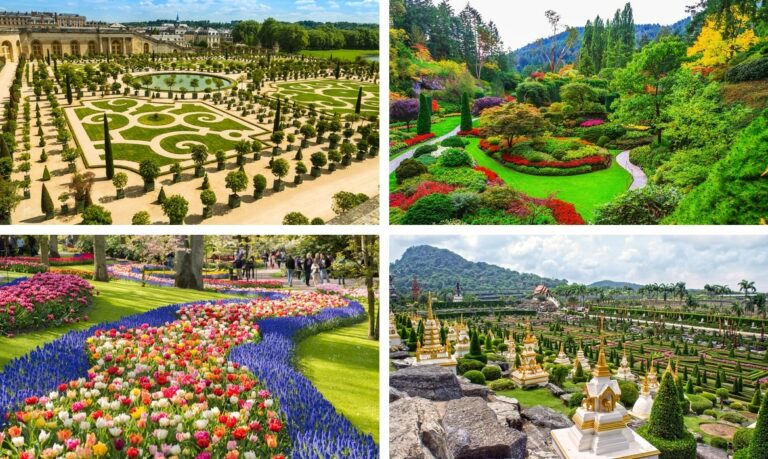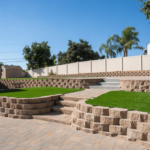The Art and Science
A combination of art and science, landscape design brings the natural world and human creativity together. A masterfully created environment can inspire feelings of inspiration, amazement, and serenity. Despite the fact that every location has its own environment and culture, there are some universal principles of landscape design that inspire designers all around the world. In this post, we will set out on a quest to find landscape design inspiration from around the globe and investigate how various cultures and climatic conditions have formed beautiful outdoor areas.
Japanese Zen Gardens
The praise has always been there for Japanese gardens, especially Zen gardens. These gardens serve as a monument to the value of harmony, simplicity, and peace in design. Zen gardens frequently have neatly manicured trees, well-placed boulders, and carefully raked gravel or sand to imitate water. These components promote reflection and meditation by representing natural environments like mountains and rivers.
The Zen garden in Kyoto, Japan’s Ryoan-ji Temple is one well-known illustration. It is a marvel of meditative design with its 15 rocks arranged in a simple pattern on a bed of raked gravel. Zen gardens have been an inspiration for Landscape architects all over the world to develop environments that encourage mindfulness and inner serenity.
English Cottage Gardens
English cottage gardens are a riot of colour and abundance, in sharp contrast to the Zen gardens’ austerity. In these gardens, which originated in the 16th century, loose plants are what distinguishes them, with the variety of plantings, and endearing dishevelled appearance. They include a wide variety of floral plants, like hollyhocks, foxgloves, and roses, frequently mixed together with herbs and vegetables.
Vita Sackville-West and Harold Nicolson created a well-known cottage garden at Sissinghurst Castle in England. A succession of garden “rooms” give visitors a sense of discovery, and the garden itself is a colourful tapestry of colours and textures. To adopt a more unhurried and naturalistic aesthetic that celebrates the beauty of wildflowers and a wide variety of plants, English country gardens influence designers
Moroccan Courtyards
Some of the most beautiful courtyard gardens may be seen throughout the world thanks to Morocco’s distinctive fusion of Arab, Islamic, and Moorish elements. Moroccan courtyards, or riads, are private retreats that offer a break from the busy metropolis. These gardens have features like elaborate tilework, fountains, rich vegetation, and cosy lounging spots.
One of the best examples of Moroccan courtyard design is the Majorelle Garden in Marrakech, which was created by Jacques Majorelle and later restored by Yves Saint Laurent. Its eye-catching blue structures and colourful landscaping produce an alluring refuge in the middle of the city. Moreover, Moroccan courtyards serve as a source of inspiration for designers who utilise complex patterns and vibrant colours to add a touch of elegance and exoticism to their work.
Balinese Tropical Paradises
Indonesia’s Bali is well known for its tranquil gardens and lush, tropical scenery. Tropical flora, water features like ponds and fountains, and traditional statues and sculptures are used in abundance in Balinese gardens. Moreover, these gardens are intended to promote harmony with nature and serve as a tranquil haven.
Furthermore, an outstanding illustration of Balinese garden design is the Tirta Gangga Water Palace in Bali. Its terraced pools, fountains, and verdant surroundings create a serene atmosphere that honours the island’s spirituality and affinity for the sea. Therefore, Balinese gardens serve as an inspiration for designers who want to create tranquil, exotic retreats by incorporating tropical elements, water features, and traditional art into their landscapes.
French Formal Gardens
There is a frequent mention of, The Palace of Versailles’ French formal garden, which is a picture of beauty and symmetry. These French-style gardens, also known as Jardins à la française and their symmetrical designs, expertly maintained hedges, and elaborate fountains and statues are what distinguish them. The majesty and precision of the French Renaissance are evident in them.
André Le Nôtre created the Gardens of Versailles, which are a masterwork of French formal garden architecture. Moreover, its expansive avenues, parterres, and reflecting pools display the richness and power of the French monarchy. Therefore, French formal gardens inspire designers to produce painstakingly designed, aesthetically attractive landscapes that emphasise precision and order.
South African Indigenous Gardens
In recent years, South Africa has developed a greater appreciation for indigenous gardening. By emphasizing native plant species, these gardens celebrate the tremendous biodiversity. Indigenous gardens are water-efficient and environmentally beneficial. Therefore, they usually exist in areas with water scarcity.
Moreover, an outstanding illustration of indigenous garden design from South Africa is the Kirstenbosch National Botanical Garden near Cape Town. It emphasises the value of protecting indigenous plant species while showcasing the nation’s varied flora in a breathtaking natural setting. Designers are motivated by South African traditional gardens to emphasise sustainability and highlight regional biodiversity in their landscapes.
Scandinavian Minimalism
The ideals of Scandinavian design have also had a significant impact on landscape architecture. Scandinavian landscapes are known for their utility, minimalism, and close ties to the natural world. Moreover, these gardens frequently have simple shapes, organic materials, and a focus on outdoor living areas.
Peter Adsett’s Tofte Manor Gardens in Norway are a prime example of Scandinavian landscaping. They successfully combine the garden with the nearby woodland to produce a beautiful and useful outdoor area. Therefore, designers are inspired by Scandinavian minimalism to create landscapes that emphasise use, simplicity, and a strong connection to nature.
Unlocking Cultural Diversity
A universal language that cuts beyond cultural and geographic barriers is landscape design. Furthermore, design professionals can produce outdoor areas that inspire a sense of location, culture, and natural beauty. They do this by taking inspiration from landscapes all over the world. Each style gives insightful perspectives into the art of landscape design. Whether it be the tranquillity of a Japanese Zen garden, the abundance of an English cottage garden, or the beauty of a French formal garden. Therefore, designers keep experimenting with and modifying these concepts. They add to the always-changing fabric of world landscape design, enhancing our outdoor spaces and our lives in the process.







